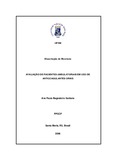| dc.creator | Santana, Ana Paula Bagesteiro | |
| dc.date.accessioned | 2006-09-14 | |
| dc.date.available | 2006-09-14 | |
| dc.date.issued | 2006-07-10 | |
| dc.identifier.citation | SANTANA, Ana Paula Bagesteiro. Evaluation of ambulatory patients in use of oral anticoagulants. 2006. 87 f. Dissertação (Mestrado em Farmacologia) - Universidade Federal de Santa Maria, Santa Maria, 2006. | por |
| dc.identifier.uri | http://repositorio.ufsm.br/handle/1/5871 | |
| dc.description.abstract | Trombotic diseases are a global health problem of multifactorial and multigenic etiology. They are characterized by the acute formation of trombus in veins and arteries. The oral anticoagulants are applied in order to create a partial deficiency on the active form of vitamin K, a co-factor in the changing of the factors of vitamin K-dependents coagulation, so that the risk of an abnormal coagulation can be reduced. The anti-vitamin K drugs or oral anticoagulants avoid the carboxylation of the II, VII, IX and X coagulation factors leading to the synthesis of the inactive factors. Several substances can change the action of oral anticoagulants, decreasing their action and increasing the thrombotic risk or increasing their activity and enlarging the blooding risk. The laboratory control of the oral anticoagulation is accomplished through the Time of Protrombine (TP) and of the Partial Thromboplastin Time (TTP) which are responsible for the success and safety of this therapeutic procedure.
The present work has analyzed the parameters regarding the laboratory accompaniment of patients in use of oral anticoagulants as well as their interference on the medicine effect aiming to reach a better security for this kind of treatment.
We can notice that most of the patients have made use of a quite rich diet in vitamin K producing variations in the values of their Normalized International Reasons (INRs) and consequently a larger difficulty in finding the right dose of the medicine for each patient. It also may be concluded that the anticoagulants response is influenced by some factors and those ones must be considered as, for example, the use of other medicines which affects the release or the absorption of the drug, laboratory technical troubles and the individual variability of each patient in relation to the drug. | eng |
| dc.format | application/pdf | por |
| dc.language | por | por |
| dc.publisher | Universidade Federal de Santa Maria | por |
| dc.rights | Acesso Aberto | por |
| dc.subject | Farmácia | por |
| dc.subject | Anticoagulantes | por |
| dc.subject | Pharmacy | eng |
| dc.subject | Anticoagulants | eng |
| dc.subject | Farmacologia | por |
| dc.subject | Pharmacology | eng |
| dc.title | Avaliação de pacientes ambulatoriais em uso de anticoagulantes orais | por |
| dc.title.alternative | Evaluation of ambulatory patients in use of oral
anticoagulants | eng |
| dc.type | Dissertação | por |
| dc.description.resumo | As doenças trombóticas constituem um problema de saúde mundial de etiologia multifatorial e multigênica. São caracterizadas por formação aguda de trombos em veias e artérias. Os anticoagulantes orais são usados para criar uma deficiência parcial da forma ativa da vitamina K, um cofator na modificação dos fatores da coagulação vitamina K-dependentes e, assim, reduzir o risco de uma coagulação anormal. Os fármacos antivitamina K ou anticoagulantes orais impedem a carboxilação dos fatores II, VII, IX e X da coagulação, levando à síntese de fatores inativos. Uma série de substâncias pode alterar a ação dos anticoagulantes orais, reduzindo sua ação e aumentando o risco trombótico ou aumentando sua atividade e elevando o risco de sangramento. O controle laboratorial da anticoagulação oral é feito através do Tempo de Protrombina (TP) e do Tempo de Tromboplastina Parcial (TTP), os quais são responsáveis pelo sucesso e segurança deste procedimento terapêutico.
Neste trabalho, foram analisados os parâmetros relativos ao acompanhamento ambulatorial de pacientes em uso de anticoagulantes orais e a interferência destes na atividade do fármaco em questão, buscando, dessa forma, uma melhor segurança para este tipo de tratamento.
Observo-se que grande parte dos pacientes fazia uso de uma dieta bastante rica em vitamina K, o que acarretava variações nos valores de suas Razões Normalizadas Internacionais (INRs) e, com isso, uma dificuldade maior em encontrar a dose adequada do medicamento para cada paciente. Também se pode concluir que a resposta dos anticoagulantes é influenciada por alguns fatores e estes devem ser considerados como, por exemplo, o uso de outros medicamentos que afetem a liberação ou absorção do fármaco, problemas técnicos de laboratório e a variabilidade individual de cada paciente frente ao medicamento. | por |
| dc.contributor.advisor1 | Silva, José Edson Paz da | |
| dc.contributor.advisor1Lattes | http://lattes.cnpq.br/1177504021154172 | por |
| dc.contributor.referee1 | Dalmora, Sergio Luiz | |
| dc.contributor.referee1Lattes | http://lattes.cnpq.br/4505166045049607 | por |
| dc.contributor.referee2 | Becker, Mônica | |
| dc.contributor.referee2Lattes | http://lattes.cnpq.br/2912332982651131 | por |
| dc.publisher.country | BR | por |
| dc.publisher.department | Análises Clínicas e Toxicológicas | por |
| dc.publisher.initials | UFSM | por |
| dc.publisher.program | Programa de Pós-Graduação em Ciências Farmacêuticas | por |
| dc.subject.cnpq | CNPQ::CIENCIAS DA SAUDE::FARMACIA | por |


